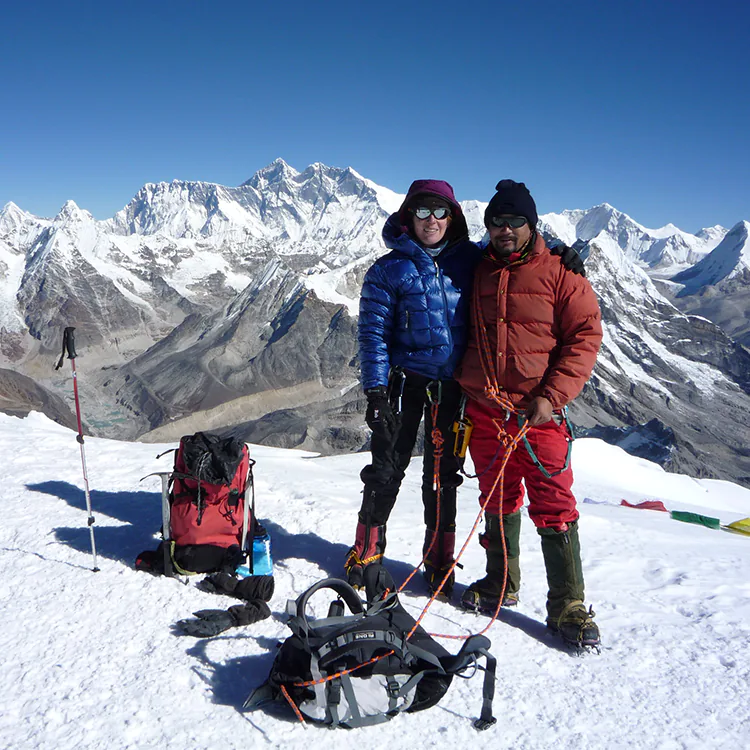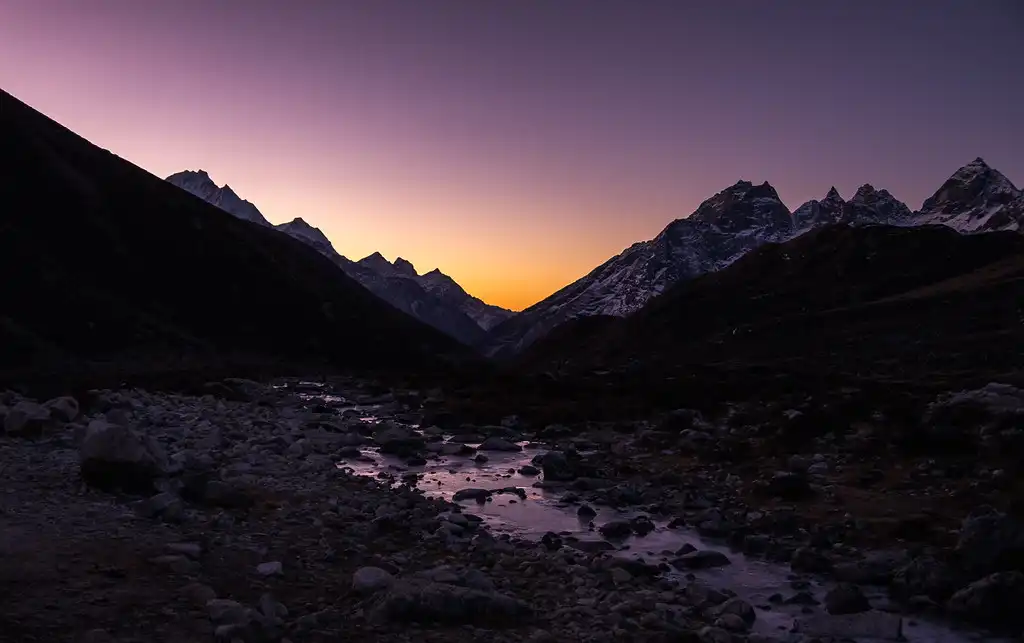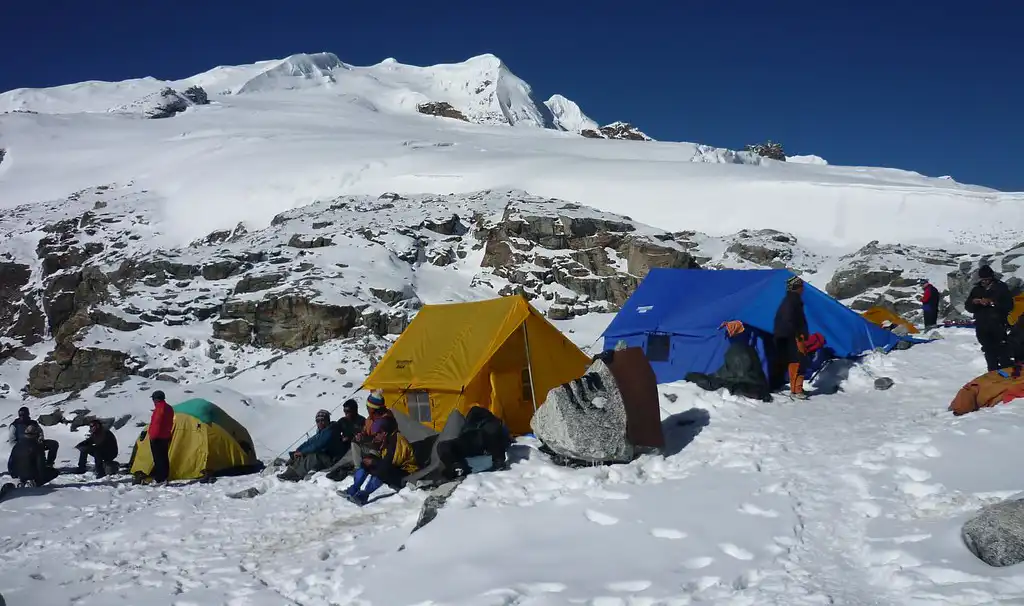Mera Peak Climbing
- Daily Breakfast
- 14 Lunch
- 14 Dinner
- Hotel in Kathmandu
- Teahouse in trek
- Tented camp during climbing
- Trekking
- Sightseeing
- Climbing


Mera Peak Climbing is the most popular and the highest permitted trekking peak, and Mera Peak Climbing lies to the south of Everest. The beautiful mountain on the trail leading to the peak consists of two valleys, Hinku and Hongu Drangkas. We chose the best season and have made the best itinerary for Mera Peak Climbing.
Mera Peak is one of the most sought-after trekking peaks in Nepal. Mera Peak lies at an altitude of 6461m above sea level. From this height, mountaineers can view the fantastic Himalayas that appear before their eyes. Mera Peak passes via culturally stimulating valleys with remote picturesque villages and forests.
Mera Peak is Nepal’s highest trekking peak and lies in the Khumbu region. Mera peak climbing will take around one week with good acclimatization packages to yield the best view of the panoramic mountain range. Even though Mera Peak is at a high altitude, moderate mountaineering experience, a good fitness level, and a keen sense of adventure make the expedition straightforward.

Mera Peak Climbing

Mera Peak Climbing

Mera Peak Climbing

Mera Peak Climbing
We complete our custom formalities at the Tribhuvan International Airport in Kathmandu. Afterward, a Peregrine Treks representative will wait at the gate to take us to our hotel. We can then spend the rest of the day taking a rest. In the evening, we try Nepalese cuisine at a welcome dinner hosted by Peregrine Treks. Overnight at a hotel in Kathmandu.
We rest for most of the day and unpack. Our climbing leaders will check our set of climbing equipment to ensure they are in good condition for our trip. We also get introduced to fellow participants and discuss our trip—overnight in Kathmandu.
Included meals: Breakfast
We catch an early morning flight to Lukla and begin our trek to Paiya after landing at the Tenzing-Hillary airport in Lukla. We walk on a jungle trail, cross a bridge over the Handi Khola and reach Surke Village. From here, we continue moving south and cross the Chutok La pass before reaching the small settlement of Paiyan, also known as Chutok. Overnight in Paiya.
Included meals: Bed, Breakfast, Lunch, and Dinner
We descend for a while and reach a small bridge. From here, the trail is slippery until we cross the Kari La pass. We walk through rhododendron and bamboo forests on a narrow mountain trail. On today’s trip, we also get in awe of the Dudhkoshi Valley. We continue our trek to Panggom Village, whose settlers depend on farming and trading. Overnight in Panggom.
Included meals: Bed, Breakfast, Lunch, and Dinner
We begin our trek after breakfast. After trekking out of Panggom, we cross the Panggom La pass. Then we ascend, walk on a steady path and turn north. We cross Peseng Kharka Khola first, then after walking for some time, reach Peeng Kharka Danda. We cross Ningsow Khola (stream) before reaching the Ningsow Village. Overnight in Ningsow.
Included meals: Bed, Breakfast, Lunch, and Dinner
From Ningsow, we climb first, descend for a while, and climb some more to reach Ramailo Danda. From here, we get extraordinary views of Mera Peak and Salpa. After ascending and descending our trail, we enter the Makalu Barun National Park. Our trail from here to Chhatra Khola is called Pasang Lhamu trail. On the way, if we are lucky, we might even come across the elusive Red Panda. Overnight in Chhatra Khola.
Included meals: Bed, Breakfast, Lunch, and Dinner
We walk towards the north on the main trail to Mera Peak. After walking on a trail next to the Majang Khola, we merge with another trail that moves alongside the Hinku Khola. Our trail moves straight ahead towards Trashing Ongma, which has seasonal tea shops. We continue our trek and cross the bridge over the Sanu Khola before reaching Kothe. Overnight in Kothe.
We trek along the ridge of the Hinku Khola in the shadow of Mera Peak. We take lunch at Gondishung, the summer herders’ settlement on the west bank of the Hinku Drangka.

Beyond Gondishung, we pass a 200-year-old Lungsumgba Gompa, where we can find Mera Peak scripted in rock along with its route to reach Mera. A short walk takes us to Thaknak, a summer grazing area with primitive lodges and shops. Overnight in Thaknak.
Included meals: Bed, Breakfast, Lunch, and Dinner
Leaving Thaknak, we follow the lateral moraine of Dig Glacier to Dig Kharka, which offers spectacular views of Charpate Himal. The trail climbs through moraines to the snout of the Hinku Nup and Shar glaciers and then climbs more steeply to Khare. From here, we can see the northern face of Mera Peak, which will be a fantastic experience. After lunch, we can hike in and around Khare. Overnight at Khare.
Included meals: Bed, Breakfast, Lunch, and Dinner
We have a particular day set aside solely for acclimatization and basic training to prepare ourselves better for the Mera Peak climb. Our climbing leader will help us polish our basic climbing techniques and demonstrate the best ways to use our climbing gears like the ice ax, harness, ascender climbing boots, and crampons. The training will also include learning the best climbing technique with the rope. Overnight in Khare.
Included meals: Bed, Breakfast, Lunch, and Dinner
We walk through a boulder-strewn course on a steep trail to reach the Mera Peak Base Camp. From here, we continue further through the Mera La pass to reach the Mera High Camp. Our path is along a rocky trail, which can be hazardous if it has recently snowed, as there are several crevasses here.

We make our way to the top of the rock band, which is marked by a large cairn. Then we set up a high camp while enjoying excellent views of Mt. Everest, Makalu, Cho Oyu, the south face of Lhotse, Nuptse, Chamlang, and Baruntse. Overnight at Mera High Camp.
Included meals: Bed, Breakfast, Lunch, and Dinner
This is an important day for the expedition. We wake up around 2 am for breakfast. It’s going to be very cold initially, but soon we warm up as we continue up the glacier and onto a peculiar ridge. The first rays of the sun hit the prominent peaks in a striking red glow. The route is still non-technical as we slowly climb higher into the ever-thinning air.
The slope steepens for a section behind the ridge, and the summit comes back into view. We may use a fixed rope at the foot of the final steep summit cone if the climbing leader believes it’s required. The summit is only a few meters away.
From the meeting, we take in spectacular views of the mighty Himalayas, including Mt. Everest (8,848m), Cho-Oyu (8,210m), Lhotse (8,516m), Makalu (8,463m), Kangchenjunga (8,586m), Nuptse (7,855m), Chamlang (7,319m), Baruntse (7,129m) and others. Later, we retrace our steps back to the high camp, where we rest for a while before descending to Khare. Overnight in Khare.
Included meals: Breakfast, Lunch, and Dinner
There is no guarantee that we will have favorable weather on our planned day for the summit. Therefore, this day is set aside as a contingency if we cannot summit the Mera on the desired day due to bad weather conditions or other unanticipated reasons. However, this day will not be required if the trip goes smoothly.
Included meals: Bed, Breakfast, Lunch, and Dinner
We trek from Khare to Kothe along the same trail used previously. After reaching Kothe, we celebrate our success by trying out local delicacies and wines. Overnight in Kothe.
Included meals: Bed, Breakfast, Lunch, and Dinner
We begin our trek to Thuli Kharka after breakfast. We climb up and descend and cross several tributaries of the Lnkhu Khola before reaching a forked trail nearby Taktho. We choose the path on our right and continue walking. Our trail passes by a Chorten, and we walk downhill on a steep trail. Next, we ascend to Thuli Kharka and pass by another Chorten on the way. Overnight in Thuli Kharka.
Included meals: Bed, Breakfast, Lunch, and Dinner
We cross the Zatrwa-La pass at 4,600. As soon as we cross the pass, we are welcomed by the sight of the beautiful Lukla Valley, surrounded by Cho Oyu, Kongde Peak, Numbur Himal, Kusum Kanguru, and other Himalayan peaks.
From Zatrwa La pass, we walk down to Chutang and then straight forward to the Lukla village. In the evening, we enjoy dinner in the Himalayas of Nepal with our crew. Overnight in Lukla.
Included meals: Bed, Breakfast, Lunch, and Dinner
We catch an early morning flight to Kathmandu. After reaching Kathmandu, we can take a rest or do some souvenir shopping. If we want to explore other areas of Kathmandu, we may do that today. Our guides can help you with both souvenirs shopping or sightseeing. There will be a farewell dinner in the evening to celebrate the climbers’ successful summit of Mera Peak. Overnight in Kathmandu.
Included meals: Bed, Breakfast, and Dinner
Your adventure in Nepal comes to an end today! There is nothing to do but trade emails with your travel companions and organize your photos. A representative from Peregrine Treks will take you to the airport approximately 3 hours before your scheduled flight. On your way home, you’ll have plenty of time to plan your next adventure in the beautiful country of Nepal.
Mera peak climbing begins with an exciting flight to Lukla, ranked number one in the world’s most dangerous airport lists. The trail passes through Paanch Pokhari, another delightful place to be at. The high camp is set at 5800m so that the summit day is shortened and enough acclimatization is achieved.
Mera Peak provides a breathtaking panoramic view and consists of peaks known globally. Five spectacular 8000m peaks are visible. To name them, Mt. Everest (8848m), Cho-Oyu (8210m), Lhotse (8516m), Makalu (8463m), and Kanchenjunga (8586m) Mountain. Trekkers can experience the Zatrwa Pass if they prefer to go the extra mile and feel the beauty of the Himalayas up close and personal.
Mera Peak Climbing‘s degree of difficulty ranges from moderate to complex. The trial will be simple, and there will be no steep and rugged ascents along the trek. Although With a height of 6,476m, you should be aware of the potential difficulties. The elevation gain during the trek will be slightly strenuous before reaching the summit of Mera Peak. Similarly, the high camp will be at a height of 5800m. Therefore, you will have to exert more effort on the trek to reach the summit.
Because altitude can create issues such as altitude sickness, you should take precautions to avoid it. Recently, there have been a few changes surrounding the glaciers of the Everest region due to global warming. It might be risky to trek above the split iceberg. Aside from that, everyone, from beginners to professional trekkers, can climb Mera Peak.
There will be no better time to climb Mera Peak than in the spring. The pure air, beautiful sky, and vast mountain scenery amaze you. The temperature during the day will be approximately 10 degrees Celsius, and at night it will drop to -5 to -10 degrees Celsius. This season lasts from February until May.
Autumn is an excellent season to climb Mera Peak following spring. This season lasts from September through November. The lush foliage and completely rhododendron waves on the scenery of the Everest Region are things to see during this season. The temperature will be approximately 5 to 10 degrees Celsius during the day and -5 degrees Celsius at night.
During this season, the Everest Region experiences heavy rain. Summer lasts from June through August, bringing heavy rain and heat waves over the country. Furthermore, some adventurous trekkers would desire to explore the misty and wet environment of the Khumbu Region and Hinku Valley during this season. The daytime temperature will range between 15 and 20 degrees Celsius, while the overnight temperature will fall below -2 degrees Celsius.
There will be snow everywhere during the winter season. Without confidence, only trekkers who enjoy trekking in the snow would choose to trek during this season. The intense cold, icebergs, and frozen formations will provide some issues throughout the expedition. This season is in effect from the end of November until the first week of February. The temperature will range from -5 to -15 degrees Celsius during the day and dip to -20 degrees Celsius at night.
Mera Peak poses a little technical difficulty because its altitude crosses 6000m. The technical requirement is fundamental and does not demand many mountaineering tools. It is an exhausting climb if trekkers do not acclimatize sufficiently at the high camp. Safety and mountaineering gear are necessary to have while climbing Mera Peak. A portable altitude chamber (PAC) or oxygen cylinder provides sufficient air to breathe during times of need.
A comprehensive medical kit and a satellite phone for communication will facilitate the rescue team in case of any emergencies. The most challenging part of the climb consists of a slope of almost 40 degrees of snow/ice. Prior mountaineering experience will help the climbers to lead the team in such harsh situations.
Teahouses, which are warm and comforting, are available throughout the trek to the high camp. All-season sleeping bags and the tent are also an alternative to stargazers who would love to stare into infinity at night. Some teahouses do not allow single-room accommodation during the summit season. These teahouses serve Nepalese, Tibetan, Indian, and the more common continental cuisines. The Sherpa community exhibits the richness and diversity within the culture and conducts welcome and farewell programs.
During the trek, acclimatization is critical. You will need adequate rest and nutrition during the trek to avoid fatigue and altitude sickness. During the Mera Peak Climbing, there will be two acclimatization days, both of which will take place in the same spot.
The Khare will be the location of the acclimatization day even after returning from the summit. During acclimatization, we explore monasteries and communities around the surrounding villages. Likewise, we will mentally and physically prepare to trek to the summit of Mera Peak. Similarly, on the acclimatization day, we will also know how we will be able to tackle the persistent trial difficulty as well as altitude sickness during the trek.
Mera Peak is categorized as complex to moderate trekking difficulty level. You must be physically and mentally fit for this excursion. Also, your medical condition and endurance level should be appropriate for this excursion since it needs a lot of persistence and significant exertion. Before trekking, you should improve your postural stability and sturdiness with workouts and fitness routines.
Similarly, those suffering from heart and lung problems should be aware of this trek because it is unsuitable. To keep the oxygen flow in your body smooth during trekking, you must train to strengthen your muscles before the trek. Swimming, cycling, uphill and downhill jogging, and stretch yoga will all be beneficial. There will also be luggage to carry on the trek, so practice carrying some bag packs and trekking uphill before the expedition. Similarly, mental health is crucial throughout the trek, so try to be more enthusiastic without thinking about any hurdles. This trek will be one of the most exciting and thrilling trekking adventures.
The day begins with a spectacular sunrise and a hearty breakfast. In the same way, we will hit the trials early in the morning. The trials feature stone and wall barriers that will guide us to our destination, traversing rivers, steady landscapes, and majestic pine and Rhododendron vegetation. After 3 hours of trekking, we will halt at one of the teahouses for a delicious lunch.
After lunch, we’ll return to the trials and continue our trek to our destination.
Furthermore, we’ll reach our goal within three more hours of trekking. Before dinner, we’ll play some cards, read some books, and wander through the settlement. After a delicious dinner, we’ll discuss the following day’s trek and get some sleep.
You will require travel insurance if you are trekking one of Nepal‘s highest and most famous treks. Mera Peak climbing is not that simple; several complications could arise. Because you never know what problems may appear throughout this expedition, travel insurance is essential. Furthermore, it would be best to get travel insurance covering you above 5000 meters in elevation.
With the relevant travel insurance, you can also receive a helicopter rescue of over 5000m. You won’t have to pay exorbitant fees if you have insurance. As a result, travel insurance is essential for safeguarding your functioning and other concerns. Similarly, you can provide trek itinerary information in travel insurance as well.
Yes, you can get a fantastic view of numerous sky-touching mountains, including Lhotse and Makalu.
Of course, staff members, guides and porters will undoubtedly accompany you on the Mera Peak Climbing.
You will be trekking for approximately 5 to 6 hours per day. Usually, you will start to walk at eight and ends before sunset.
Teahouses will serve as your accommodation along the trek and tented camp during the expedition.
While climbing Mera Peak, you’ll experience the customs and cultures of the sherpa people as well as the alpine lifestyle.
During the trek, the usual group size will be around 2 to 8 individuals.
During Mera Peak Climbing, you can see the Mera glacier and its streams.
Certainly, trekking from the fringe of the Sagarmatha and Makalu Barun National Parks will surely provide you with the chance to see some rare species along the route.
